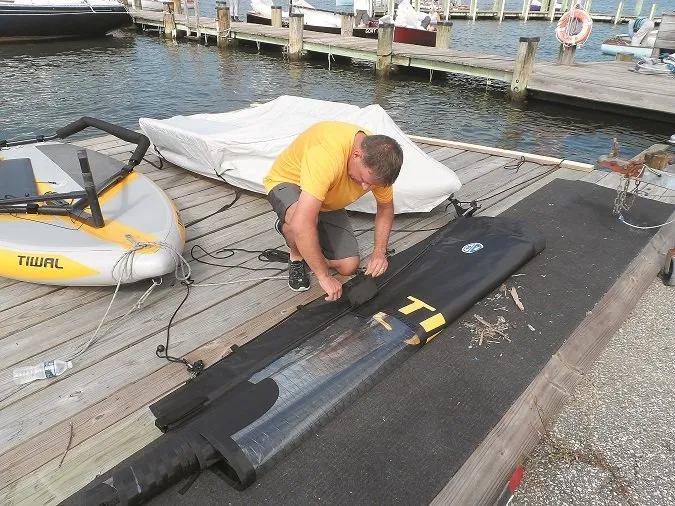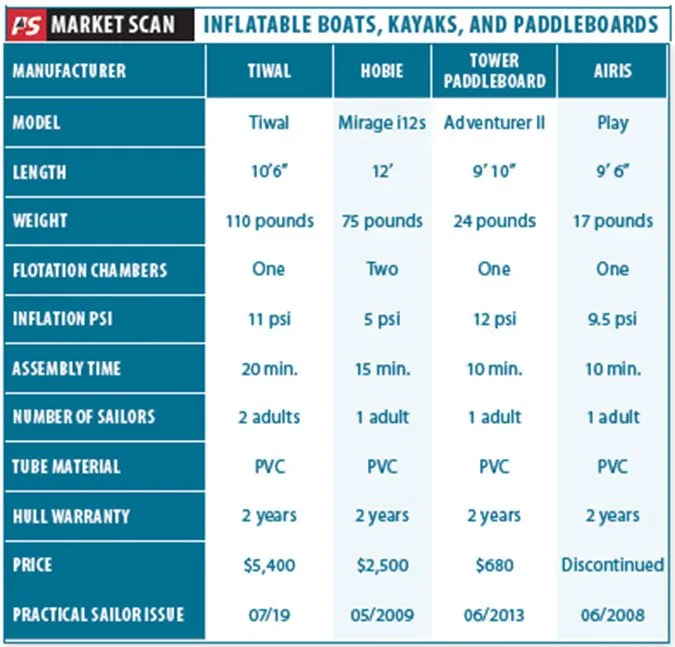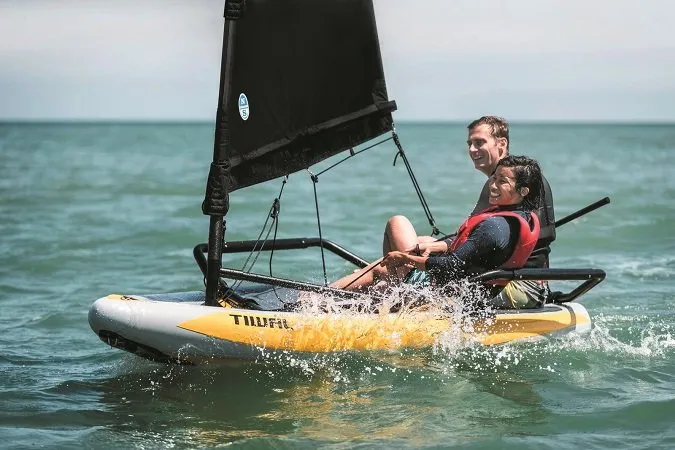Sailing a cruising boat is many things-rewarding, sometimes adventurous, and often relaxing-but seldom viscerally fun, not in the way that a beach cat or performance dinghy saturates the senses and puts you in touch with the wind and waves. It doesn’t communicate every ripple and puff, it doesn’t thrill, and it doesn’t allow you to push the edge. It’s the difference between driving a Winnebago and riding a bicycle. For many of us, our love of sailing began with something fast and volatile, and by-and-by, we miss it dearly. And yet as much as wed like to strap a Laser or Hobie to the foredeck, thats not happening.
The Tiwal 3 is an unconventional answer. The skiff-like hull is constructed using high pressure drop-stitch construction (PVC), like inflatable stand-up paddle boards and the Walker Bay Airis Play kayak (Kayaks for Cruising Sailboats, PS October 2017). This creates a very light and stiff hull to which a frame integrating mast support, moderate hiking racks, running rigging, dagger board, and rudder are attached using numerous double Velcro wraps. The result is surprisingly rigid, giving no hint that it is an inflatable, other than being easier on the knees when tacking. Assembly, from a pair of bags to the water, takes about 20 minutes.

At just 100 pounds, it is easily launched from the foredeck like a typical tender. The carbon fiber mast (five sections) is paired with a square top, fully battened mainsail, which is easily adjusted from full and powerful to flat and twisted, according to downhaul tension and the wind. Two sail sizes are available, 54 and 75 square feet, and the larger sail can be reefed to 54 square feet using a novel Fastex buckle arrangement (you must return to the beach to reef).
Sailing is reminiscent of a Sunfish, but with a full-batten sail and better hardware. Its not as zippy as a Laser, but its not as tippy either, and you can’t really carry a Laser on deck. Our test sail was in light winds, weaving through a harbor crowded with anchored yachts and traffic.
The high-aspect daggerboard (2 3) and rudder allowed it to point high even in our unpracticed hands, as long as we didn’t over sheet or pinch. Tacking was fast and reliable, and we never banged a knee on the deck.
The sail hangs low over the deck, but the carbon boom is sheathed in the sail and too light to pose a serious of hazard. The tiller and sheeting arrangements are smooth and precise; the driver will feel confident throwing the boat around when in a breeze. We watched video of the boat planning, and it felt well balanced to do so.
Although we have not done long- term testing, we talked to a few owners and closely examined the boat, on shore and in the water. It is simple, well made, and should hold up like any similar inflatable tender, which is to say pretty well, so long as you avoid dragging it over rocks.

Conclusions
We see this novel design in much the same way we see high-pressure inflatable kayaks; we like fiberglass a little bit better on the water, but these are real boats and the performance is quite impressive for something that fits in a pair of bags.
Too many times we’ve e felt frustrated at anchor, watching dinghies dance across the harbor while Im stuck with a boring tender and a big boat that isn’t made for afternoon play. If a zipping around the harbor in a responsive dinghy, like the Tiwal, doesn’t make you smile, you might want to rethink your choice of recreational fun.

The Tiwal has a very light and stiff hull to which a frame integrating mast support, moderate hiking racks, running rigging, dagger board, and rudder are attached using numerous double Velcro wraps. The result is surprisingly rigid inflatable.
- Double-wrap hook-and-loop straps secure the hiking racks/frame.
- The mast support is integrated into the frame and hiking wracks. This simplifies assembly and adds stiffness to the rig.
- The boat was stable enough to step onto right from the dock.



































